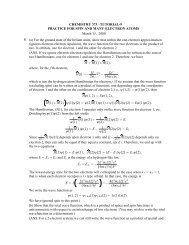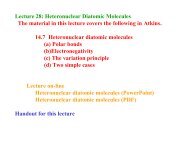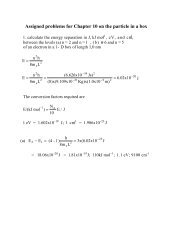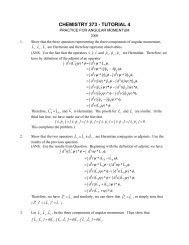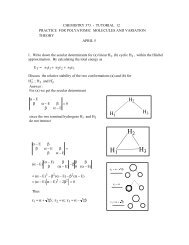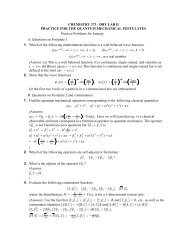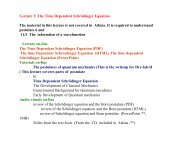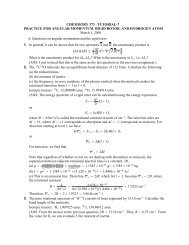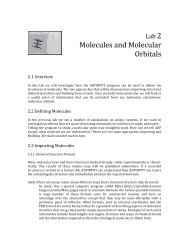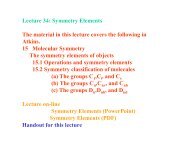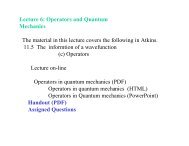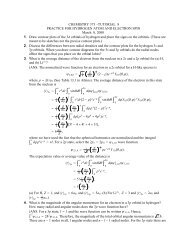Solvation free energy and Modeling chemical reactions - Cobalt
Solvation free energy and Modeling chemical reactions - Cobalt
Solvation free energy and Modeling chemical reactions - Cobalt
You also want an ePaper? Increase the reach of your titles
YUMPU automatically turns print PDFs into web optimized ePapers that Google loves.
[Note that some of what follows is additional to what is found in the text – in particular,the importance of anisotropy <strong>and</strong> solute contributions in solvation <strong>free</strong> <strong>energy</strong>, <strong>and</strong> someparts of the discussion of slow-growth methods, are new. As well, material has been rearrangedfor (I hope) clarity. – Jason ]Non-electrostatic contributions to solvation <strong>free</strong> <strong>energy</strong>• Recall: ∆G sol=∆G elec+∆G vdW+ ∆G cav• The 1 st term (∆G elec) has been treated. Here we consider the non-electrostaticterm ∆G vdW+∆G cav, which can be treated in two different ways.As separate terms• ∆G vdW<strong>and</strong> ∆G cavcan be treated separately by models approximating theirphysical origin.• ∆G vdWcan be approximated by a continuous distribution function [Floris, F. <strong>and</strong>Tomasi, J.; Journal of Computational Chemistry, 10 (1989), 616].• ∆G cavis treated by scaled-particle theory, in which the solute cavity is “growninto” the solvent.By linear approximation• The first solvation shell is expected to account for most of the van der Waalsinteraction <strong>energy</strong>. The number of solvent molecules in the first solvation shell –<strong>and</strong> therefore ∆G vdW, assuming each molecule interacts with the solute in asimilar manner – is therefore expected to be approximately proportional to thesolvent-accessible surface area A of the solute.• ∆G cavmight be expected to follow a similar trend, since the solvent moleculesmost strongly affected by cavity formation are those at the cavity surface. If, as inthe scaled particle method, the cavity is “grown” into the solvent:
Using the CM/ECF Online Manual(If you need help, refer to the Video - Using the CM/ECF Online Manual)1. List one way to access the CM/ECF Online Manual.2. Why is it important to use the CM/ECF Online Manual when filing in CM/ECF?Filing Documents in CM/ECF(If you need help, refer to the Video - Filing Documents in CM/ECF)1. Which CM/ECF menu option allows you to find a Document Event?2. Why is it important to use the correct document event when filing in CM/ECF?3. This video names five components which ensure a document is filed accurately. Listthree of these components.a.b.c.4. What are the consequences of not filing documents correctly in CM/ECF?CM/ECF Test / FA - AF 2
1. We begin by choosing a model, <strong>and</strong> therefore determining the form of theenthalpic surface.2. The desired transition state (a saddle point with steepest-descent paths leadingto products <strong>and</strong> reactants) <strong>and</strong> the intrinsic reaction path (IRP, the union ofthose steepest-descent paths) are determined.3. The system is warmed to a finite temperature. While the remaining degrees of<strong>free</strong>dom are allowed to evolve <strong>free</strong>ly, the component along the IRP is slowly“dragged” from products to reactants. In this way, the space surrounding theIRP is sampled <strong>and</strong> the ensemble-average force required to maintain theconstraint can be evaluated at each location along the IRP.4. The mean force is integrated to give a <strong>free</strong> <strong>energy</strong> profile for the reaction.• The process is illustrated schematically below.→Enthalpic surfaceIRP↓←Reaction coordinateIntegration of mean forceSampling
Potential of mean force: An application• The application of slow-growth IRC methods to the SN 2 reaction of methylchloride with the chloride anion, as investigated by Artur Michalak of the Zieglergroup, will be discussed.• Of particular interest (in addition to the quality of the predicted energies) is theevident rotational <strong>free</strong>dom of the reactants relative to one another at coordinatesquite close to the transition state – a phenomenon not observed in enthalpic IRCcalculations.Empirical Approaches• Force field methods have been developed to treat <strong>reactions</strong>.• As an example: The reaction of enol boronates with aldehydes, shown below,was investigated:OBL 2OH R 2OOHR 1R 1 R 2Each conformer of the starting material can go through one of two transitionstates – the “chair” conformation, or the “boat” conformation. These transitionstates are shown below for the trans starting material:OR1BOR 2OOO OBR 2 BR 2R 1 R 1
R 2OOOB OB OB ODepending on the relative orientations of the two reactant molecules (R 2 axial orequatorial), each transition state can, in turn, give one of two productconformations. Both <strong>reactions</strong> shown above lead to the product given below:OOHR 1 R 2In this study, empirical parameters were fit to match experimentally-determinedtransition state structures where R 1 = R 2 = H. These parameters were then usedsuccessfully to predict product ratios for other substituents, whose interactionsthrough the reaction were primarily steric.



